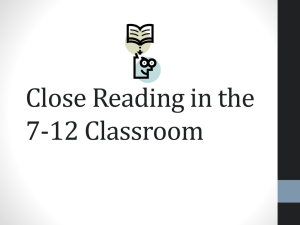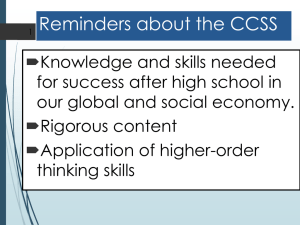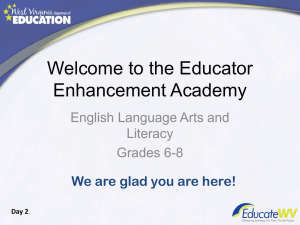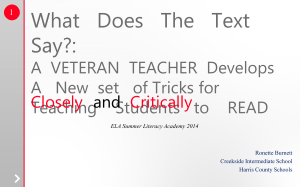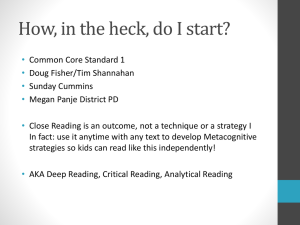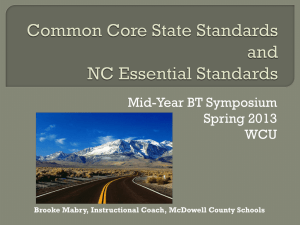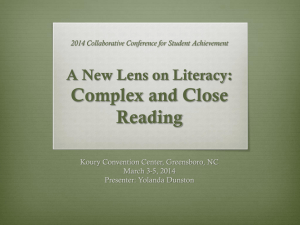Close reading in the Elementary Classroom
advertisement
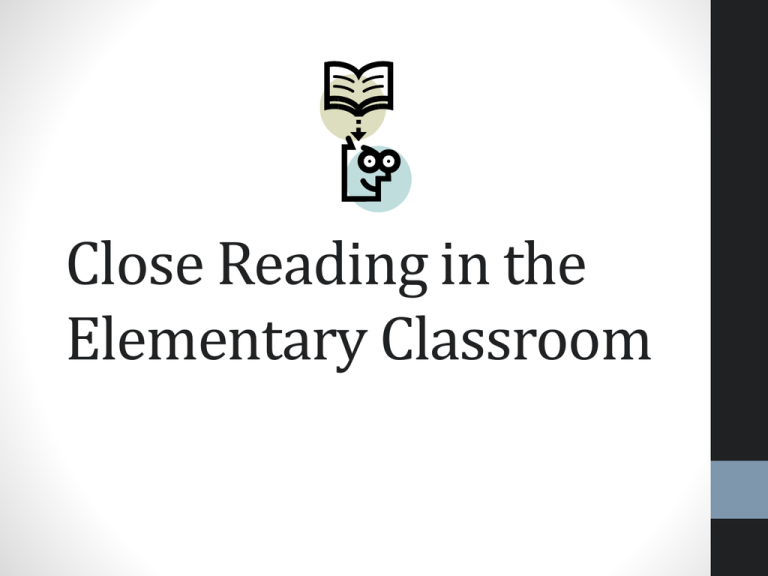
Close Reading in the Elementary Classroom Today’s Learning Targets: • I will be able to define the term close reading and explain why it is important for students to be able to closely read complex texts. • I will be able to explain how the Common Core Standards include all of the skills involved in close reading. • I will understand the criteria for selecting complex texts for close reading and be able to select appropriate texts for my students. • I will understand how to use the gradual release of responsibility to teach my students to be close readers. • I will be able to use the Common Core Standards to prepare text dependent questions and evaluate questions that already exist in my lessons or textbook series. Pre-K-5 Balance of Informational text and Literature 6-12 Knowledge in the Disciplines Academic Vocabulary Close Reading Staircase of Complexity Writing from Sources Text-Based Answers We just discussed… Manifest Destiny Where the Wild Things Are • • • • Increasing size of images Pointy icons Changing Moon Enjambment, assonance, and consonance • Paratactic language • Notion of wild vs. domestic and civilized vs. uncivilized • • • • Hypotactic Language Incremental repetition Use of asyndetons Momentum of argument and prose This is how adults do a “close reading”! Note the Progressions (Example: R.L.1) Pre-K With prompting and support, ask and answer questions about details in a text. K With prompting and support, ask and answer questions about key details in a text. 1 Ask and answer questions about key details in a text. 2 Ask and answer such questions as who, what, when, where, why, and how to demonstrate understanding of key details in a text. 3 Ask and answer questions about key details in a text, referring explicitly to the text as the basis for the answers. 4 Refer to details and examples in a text when explaining what the text says explicitly and when drawing inferences from the text. 5 Quote accurately from the text when explaining what the text says explicitly and when drawing inferences from the text. 6 Cite textual evidence to support what the text says explicitly as well as inferences drawn from the text. What is “close reading”? Turn to someone near you and discuss what your understanding of close reading is and what you think it looks like at your grade level. What is “close reading”? • Read the article from Educational Leadership entitled “Closing In on Close Reading”. • As you read, please do the following: • Underline important points • Write a ? next to anything you find confusing • Under each column of text (except for the one on the first page), write one sentence that summarizes the main idea of that section. Discuss What You Read • When you receive the signal to start, get up and find a partner. • Be ready to discuss the questions that appear on the screen with your partner. • When you receive the signal to switch, move to another area of the room and find a new partner. • You and your new partner will also discuss questions that appear on the screen. Let’s begin! Find a partner! According to the text, what is “close reading”? What are the key skills involved in close reading? How is this similar to or different from how we have taught students to read in the past? Switch Partners! What are the benefits of using short texts for close reading? What could a teacher do to gradually increase students’ abilities to use the process of close reading independently? According to the author of this article, what kinds of questions should students ask or be asked about a text? Which types of questions do you ask most frequently? Which types of questions appear in our textbook series? Which ones are left out? Please return to your seat. Does anyone have any questions at this point? What is close reading? • • • • Engaging with a text of sufficient complexity directly Examining meaning thoroughly and methodically Reading and rereading Understanding the central ideas and key supporting details • Reflecting on: • the meanings of individual words and sentences • the order in which sentences unfold • the development of ideas over the course of the text • Ultimately arriving at an understanding of the text as a whole (PARCC, 2011, p.7) Selecting the right text is very important! Criteria for Text Selection Quantitative Qualitative Reader and Task • Aligned with the Lexile (or other computergenerated) levels outlined in the standards • Allows you to teach the skills described in the standards • Has a complex level of meaning, purpose, structure, language, and knowledge demand • Content-rich and interesting • Models the kind of thinking and writing students should aspire to in their own work Lexile Ranges Text Complexity Old Lexile Ranges Grade Band in the Standards K-1 N/A Lexile Ranges Aligned to CCR expectations N/A 2-3 450-725 450-790 4-5 645-845 770-980 6-8 860-1010 955-1155 9-10 960-1115 1080-1305 11-CCR 1070-1220 1215-1355 Go to www.lexile.com to analyze a text’s Lexile level for free. For Elementary Teachers • Non-Fiction or Fiction (remember the 50/50 rule) • Presents sophisticated structure or issue (i.e. changes point of view, focuses on a father losing his job) • Integrates captions, photographs, graphs, tables, etc. (non-fiction) • Academic Vocabulary How to Support Students TEACHER RESPONSIBILITY “I do it.” Modeling Guided Instruction “We do it.” Collaborative Work Independent Work “You do it together.” “You do it alone.” STUDENT RESPONSIBILITY THE GRADUAL RELEASE OF RESPONSIBILITY FRAMEWORK Basic Lesson Structure Beginner Intermediate Advanced 1. The teacher reads the text out loud to students without stopping to give them a sense of the overall plot or main idea. 1. The students read the text silently one time through to get a sense of the overall plot or main idea. 1. The student reads the text silently one time through to get a sense of the overall plot or main idea. 2. The teacher re-reads small chunks of the text at a time and asks discussion questions. The students may work in pairs first, but answers are shared with the whole group. 2. Teacher re-reads small chunks of the text out loud and asks discussion questions. Students may discuss the questions as a whole group, in pairs, or small groups. 2. The student re-reads small chunks of the text at a time, stopping to make notes, underline key points, and ask himself questions. 3. The students and 3. The students write a teacher develop a written written response to a response to a prompt prompt independently. together. 3. The student writes a response to a prompt and provides evidence from the text in his answer. Text Dependent Questions Require students to… • Cite evidence • Determine the central idea • Analyze how the author structures the text and develops ideas/claims • Determine the meanings of words and phrases • Determine the point of view or purpose (From the Common Core Standards) “Don’t Wait” • Ask text dependent questions frequently, and throughout the selection rather than waiting until the end of a selection. • Experiment with different activities for keeping students engaged (i.e. think-pair-share, stop and jot, small groups, etc.) Text-Dependent Questions are not… Low-level, literal, or recall questions Focused on comprehension strategies Just questions… 28 • • • • • Can only be answered with evidence from the text. • Focus on word, sentence, and paragraph, as well as larger ideas, themes, or events. • Focus on difficult portions of text in order to enhance reading proficiency. • Can also include prompts for writing and discussion questions. Can be literal (checking for understanding) but must also involve analysis, synthesis, evaluation. 29 Text-Dependent Questions... Non-Examples and Examples Text-Dependent In “Casey at the Bat,” Casey strikes out. Describe a time when you failed at something. What makes Casey’s experiences at bat humorous? In “Letter from a Birmingham Jail,” Dr. King discusses nonviolent protest. Discuss, in writing, a time when you wanted to fight against something that you felt was unfair. What can you infer from King’s letter about the letter that he received? In “The Gettysburg Address” Lincoln says the nation is dedicated to the proposition that all men are created equal. Why is equality an important value to promote? “The Gettysburg Address” mentions the year 1776. According to Lincoln’s speech, why is this year significant to the events described in the speech? 30 Not Text-Dependent Three Types of TextDependent Questions consider the following three categories: 1. 2. 3. Questions that assess themes and central ideas Questions that assess knowledge of vocabulary Questions that assess syntax and structure 31 When you're writing or reviewing a set of questions, • • Use a backwards design approach • Create a set of questions that will lead students towards that understanding • This should be the focus of the culminating assignment Clarify your own understanding of the themes and central ideas first 32 Assessing Themes and Central Ideas Assessing Themes and Central Ideas Example: Because of Winn Dixie • Two people of very different ages may still have much in common and become friends. • Possible Questions: • Why does Opal spend so much time with Miss Franny, the town librarian? • Can people of different ages still be friends? Use evidence from the text to support your answer. 33 • Core Understanding and Key Idea: Assessing Vocabulary Which words should be taught? • Essential to understanding text 34 • Likely to appear in future reading Which words should get more time and attention? • More abstract words (as opposed to concrete words) persist vs. checkpoint noticed vs. accident • Words which are part of semantic word family secure, securely, security, secured Assessing Vocabulary • “To avoid someone means to keep away from them so that you don’t have to see them and they don’t have to see you. How did the boys avoid meeting Bolivia at first?” (pg. 23) • Re-read the last two paragraphs on page 39. Rory had a “strong suspicion”. What is a suspicion? What details in the story made Rory suspicious of Bolivia? 35 Example: “Hot and Cold Summer” - 5th grade fictional text Assessing Syntax Syntax can predict student performance as much as vocabulary does. • Questions and tasks addressing syntax are powerful. 36 • Example: Who are the members of the wolf pack? How many wolves are in the pack? To answer this, pay close attention to the use of commas and semi-colons in the last paragraph on pg. 377. The semi-colons separate or list each member in the pack. Assessing Structure • “Look at the illustrations on page 31. Why did the illustrator include details like the power outlets in the walls?” • “Dillard is careful to place opposing descriptions of the natural and man-made side-by-side. How does this juxtaposition fit with or challenge what we have already read? Why might she have chosen this point in the text for these descriptions?” 37 Examples: Culminating Tasks • • Should relate to core understanding and key ideas. • Whenever possible, try to get your students to make claims or arguments and support them with evidence. Examples: “The title of this selection is ‘Because of Winn-Dixie.' Using your answers from the questions above and class discussion, explain why this is an appropriate title for the selection. Be sure to clearly cite evidence from the text for each part of your answer.” “Officer Buckle’s final safety tip is 'ALWAYS STICK WITH YOUR BUDDY.' How did he and Gloria each learn this lesson for themselves throughout the story?” 38 A coherent sequence of text dependent questions will scaffold students toward successfully completing the culminating task. Progression of Text Dependent Questions Structure Vocabulary and Syntax Themes and Central Ideas Culminating Task Planning Close Reading Questions Stop After Question pg. 31 Why did the illustrator include details like the power outlets in the walls? How will students answer it? Discuss with a partner Type of Analysis Structure CCLS RL.K.7 Your Task: • Take out the text you brought with you today. Is it an appropriate text for close reading? Evaluate it using the criteria you learned about today. • Write at least one of each type of text-dependent question about the text you selected. OR • Review the questions you normally use with this text selection (these could be the questions from your textbook series) and decide whether or not they are aligned with the Common Core standards. Keep the ones that are, and add questions to address any gaps. Final Thoughts: • Begin to incorporate close reading into your instruction on a regular basis if you haven’t already. • Use the gradual release of responsibility to help your students become more independent: • Model how you closely read and analyze a text • Read texts out loud and discuss text dependent questions together • Have students work in pairs or small groups to discuss texts • Help students develop a set of skills (i.e. annotating text, asking questions, etc.) to be able to closely read and analyze text on their own. • Be sure that you are asking the right types of text dependent questions. Example Lessons http://vimeo.com/album/2192390/video/56069187 http://www.engageny.org/resource/close-reading-strategieswith-informational-text-by-expeditionary-learning
